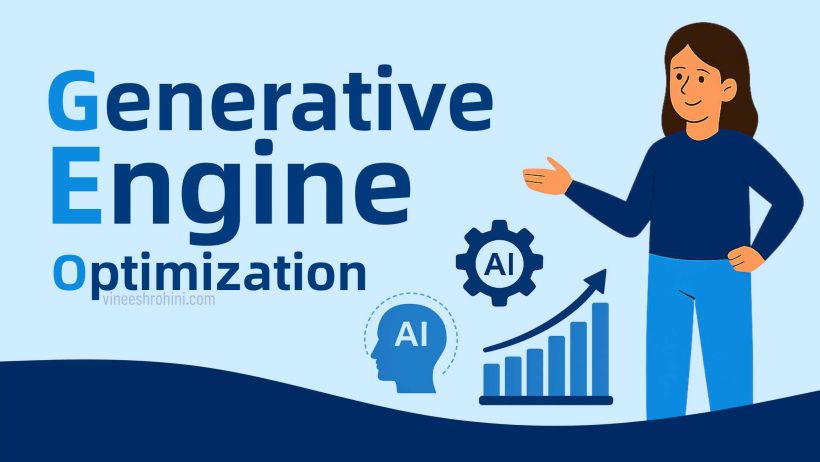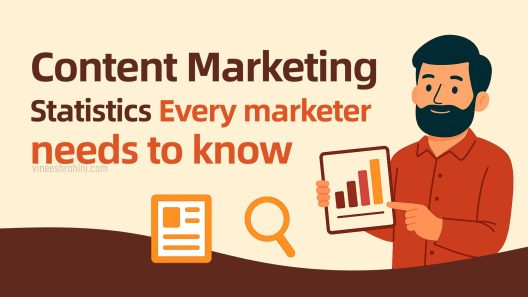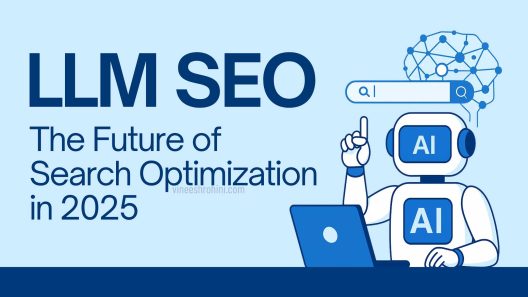Generative Engine Optimization : The digital marketing landscape is evolving at lightning speed. Traditional search engines like G, Bing, and Yahoo defined the first generation of online discovery, shaping the way businesses attracted customers. But today, AI-driven answer engines powered by Large Language Models (LLMs) are transforming how users search, learn, and make decisions. Instead of browsing through multiple pages of results, users now rely on generative AI systems like ChatGPT, G Gemini, Claude, or Microsoft Copilot to provide direct, conversational answers.
Table of Contents
This shift has created a new discipline in digital marketing known as Generative Engine Optimization (GEO). Just as Search Engine Optimization (SEO) was about ranking in search engine results pages (SERPs), GEO is about optimizing your brand and content so that generative AI engines cite, recommend, and include your information in their responses.
In this comprehensive guide, we’ll explore what GEO is, how it works, why it matters, the strategies businesses can use to succeed, challenges they may face, and what the future holds. By the end, you’ll have a complete understanding of how Generative Engine Optimization can position your brand in the AI-first search era of 2025 and beyond.
What Is Generative Engine Optimization (GEO)?

Generative Engine Optimization, or GEO, is the practice of tailoring your content, data, and digital presence to improve visibility within AI-powered generative engines. Unlike traditional SEO, which focuses on ranking higher on G ’s SERPs, GEO ensures that your brand or website is referenced in AI-generated answers when users ask questions.
For example:
- Traditional SEO: A user types “best running shoes 2025” into. They get a ranked list of blogs and e-commerce websites.
- GEO: A user asks ChatGPT or Gemini, “What are the best running shoes for marathon training in 2025?” The AI generates an answer highlighting top brands and possibly citing sources. If your brand is optimized for GEO, it gets mentioned in that curated response.
In essence, GEO is the next evolution of SEO, adapting to the rise of conversational search and AI-driven answer engines.
Also Read : Hyperlocal SEO : Winning Small Local Markets for Higher ROI : Comprehensive Guide 2025
Why GEO Matters in 2025
The importance of GEO can’t be overstated. Businesses that fail to adapt risk losing visibility in a world where AI-first discovery is overtaking search-first discovery. Here are the main reasons why GEO is critical:
1. User Behavior Is Shifting to AI Engines
Consumers are increasingly relying on generative AI tools for information. Instead of searching on G, they ask ChatGPT or Copilot for direct, curated, and conversational answers.
2. Reduced Dependence on Search Engine SERPs
With AI-driven summaries replacing lists of links, traditional SEO visibility is shrinking. GEO ensures your brand remains visible even without a top SERP ranking.
3. Authority Through AI Recommendations
When an AI engine recommends your product or content, users see it as credible and objective. GEO boosts your brand authority by securing mentions in these AI-generated recommendations.
4. Competitive Edge for Early Adopters
Just like SEO pioneers dominated G rankings in the 2000s, early adopters of GEO will dominate the AI-driven discovery ecosystem.
5. Integration with Decision-Making
Generative AI engines don’t just inform; they influence purchasing decisions directly. Being part of AI answers increases chances of direct conversions.
GEO vs SEO: What’s the Difference?
While GEO is an evolution of SEO, there are significant differences between the two.
| Factor | Traditional SEO | Generative Engine Optimization (GEO) |
|---|---|---|
| Platform | G, Bing, Yahoo | ChatGPT, Claude, Gemini, Copilot, Perplexity |
| Output | Ranked links (SERPs) | Conversational, synthesized answers |
| User Input | Keywords | Natural language questions & prompts |
| Optimization Focus | On-page SEO, backlinks, technical SEO | Conversational content, structured data, knowledge graph presence |
| Measurement | Impressions, clicks, CTR, backlinks | Mentions in AI responses, citation frequency, AI-driven referrals |
| Business Goal | High SERP ranking | Inclusion in AI answers & recommendations |
This shows why SEO alone is no longer enough in 2025. GEO is necessary to maintain visibility in the age of AI-first discovery.
Core Pillars of Generative Engine Optimization

Succeeding in GEO requires a different approach from traditional SEO. The following pillars define success in GEO:
1. Conversational and Contextual Content
Generative engines prioritize content written in a natural, question-answer style. Businesses should structure their blogs, FAQs, and product descriptions around conversational queries.
Example: Instead of “Best hotels in Paris,” use “What are the best family-friendly hotels in Paris for summer 2025?”
2. Entity Optimization & Knowledge Graphs
AI engines rely heavily on entity recognition. Brands must ensure their details (business name, product data, industry associations) are optimized for inclusion in knowledge graphs and structured databases.
3. Structured Data & Metadata
Implementing schema markup makes content easier for AI to parse and include. Product data, reviews, pricing, and company information must be structured for machine readability.
4. Authority and Trust Signals
AI engines value credibility and expertise. Publishing original research, case studies, and authoritative insights increases chances of being referenced.
5. Multi-Channel Content Distribution
The more widely your content is shared and cited across social media, forums, and news outlets, the more likely generative engines will include it in responses.
6. Content Freshness
Since LLMs are frequently updated, outdated information is excluded. Businesses must consistently refresh their content with up-to-date stats and insights.
Buy Now : AIOSEO – All in One SEO Plugin For WordPress
Strategies for Implementing GEO
Businesses can adopt practical strategies to align with GEO best practices:
- Optimize for Natural Language Questions
- Use long-tail queries in a conversational tone.
- Include FAQ sections in blogs.
- Leverage Topic Clusters
- Build pillar content with supporting articles around specific themes.
- Example: A health blog could have a main guide on “Nutrition in 2025” supported by subtopics like “plant-based diets,” “intermittent fasting,” and “AI-driven meal planning.”
- Publish Original Data
- Generative engines value unique insights. Create research reports, surveys, and whitepapers.
- Focus on Multi-Format Content
- Use text, video, infographics, and podcasts. LLMs may reference multiple media types.
- Improve Brand Visibility Across Platforms
- Maintain presence on Wikipedia, Wikidata, news outlets, and industry directories.
- Strengthen E-E-A-T (Experience, Expertise, Authoritativeness, Trustworthiness)
- Publish bylined articles from credible experts.
- Get featured in industry interviews and partnerships.
- Track AI Mentions
- Use tools that measure brand mentions in AI answers to monitor visibility.
Challenges of GEO
While GEO offers huge opportunities, it comes with challenges:
- Opaque AI Algorithms
- Unlike G SEO guidelines, AI selection criteria are not transparent.
- Traffic Attribution
- Since users often don’t click links, it’s harder to measure referral traffic from AI-generated answers.
- Content Ownership
- LLMs summarize content, sometimes without citation, raising issues of credit and visibility.
- Rapid Model Evolution
- AI models update frequently, making optimization a continuous effort.
- Bias in AI Responses
- Generative models may favor well-established brands, making it harder for smaller businesses.
Future of GEO: What’s Next?
GEO is just getting started, but it will define the next decade of digital marketing. Here’s what the future may hold:
- AI Answer Engines as Default Search: By 2027, most consumer queries may bypass G SERPs entirely.
- Personalized GEO: AI-generated answers will be customized to user history and preferences.
- Direct Conversions in AI Interfaces: Users may purchase products directly within AI chat interfaces.
- Rise of Proprietary Content: Businesses with exclusive, unique insights will dominate GEO.
- Ethical Regulations: GEO strategies may face compliance standards to ensure transparency in AI-driven recommendations.
Points to Remember
- GEO is the future of SEO in an AI-first world.
- It focuses on optimizing for generative AI engines, not just search engines.
- Businesses must embrace conversational content, structured data, authority building, and content freshness.
- Early adopters will have the same advantage in GEO that pioneers had in SEO two decades ago.
Conclusion

The world of digital discovery is undergoing its biggest transformation since the invention of G. Generative Engine Optimization (GEO) is no longer optional — it’s essential for businesses that want to stay relevant in 2025 and beyond. Just as SEO was the golden ticket for online visibility in the past, GEO is the blueprint for AI-driven visibility in the future.
Buy Now : AIOSEO – All in One SEO Plugin For WordPress
By focusing on conversational content, knowledge graph presence, authority signals, and continuous content updates, brands can ensure they remain part of the answers that matter most. The businesses that adapt early will not just survive this transformation but thrive as leaders in the age of AI-first search.
Disclaimer
This article is for educational and informational purposes only. Generative Engine Optimization (GEO) is an emerging discipline, and strategies may evolve as AI technologies advance. Businesses should combine this knowledge with professional advice and continuous experimentation. The author is not responsible for specific business outcomes resulting from applying these strategies.








